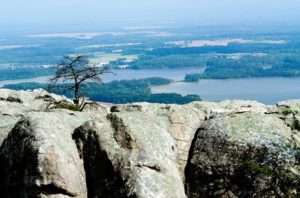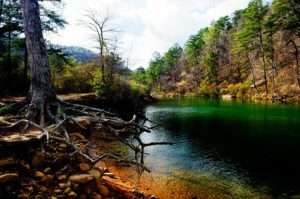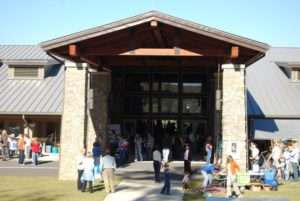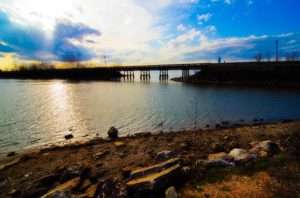During the Late Woodland period around AD 700-1100, people living at the confluence of the Chatuga, Coosa, and Little Rivers established one of the largest and most elaborate communities in the region. At the time, populations were on the move and groups from the Tennessee River and Black Warrior River Valleys to the north and west were beginning to settle in an area that had traditionally been occupied by people associated with cultures centered in northwest Georgia. The appearance of these new groups may not have always been peaceful as protective palisades were built around several of the villages. In addition, some villages were intentionally built on high ground with clear views of the river bottoms.
These new people built villages along the banks of the Chatuga, Coosa, and Little Rivers. The Coker Ford site overlooks the Little River and includes the largest of these villages along with two unusual stone-covered earthen mounds built to memorialize their ancestors.
By studying the pottery styles made and used at these sites, archaeologists believe that their culture originated in the Tennessee River Valley near Guntersville and that they had moved to the area in search of new opportunities. They brought new ideas and technologies with them, but quickly began to take on some of the cultural traits of the people who already occupied the area. In fact, their influence may have been directly linked to the development of the large Mississippian mound complex of Etowah, near the head of the Coosa River in northwest Georgia. Etowah grew to control a vast area of the Upper Coosa River Valley and was likely one of the larger towns the Spanish encountered during their first exploration of the Southeast in 1541. By then, the Coker Ford site had long been abandoned and the mounds left as a monument to the ancestors.
This site is very important to numerous Southeastern indigenous tribes who assert an ancestral connection with those who built and occupied Alabama’s ancient mounds. The earthwork landscapes and the objects and information recovered from them reveal a rich cultural tradition that still thrives today among these tribes. Our indigenous mound sites represent a heritage for all Alabamians to cherish, and it is important that we protect and preserve them for future generations.




